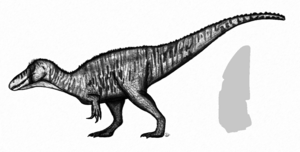Ostafrikasaurus facts for kids
Ostafrikasaurus was a meat-eating dinosaur. It was a type of theropod dinosaur. This dinosaur lived in what is now southeastern Tanzania. It lived during the Late Jurassic period. This was about 148 million years ago. We only know about Ostafrikasaurus from a single fossil tooth. This tooth was about 49 mm (1.9 in) long. A scientist named Eric Buffetaut studied this tooth. He believes it is the oldest known evidence of a spinosaurid dinosaur. Spinosaurids were special dinosaurs. They looked a bit like crocodiles and mostly ate fish.
Quick facts for kids Ostafrikasaurus |
|
|---|---|
 |
|
| Speculative restoration and holotype tooth | |
| Scientific classification | |
| Genus: |
Ostafrikasaurus
|
| Species: |
crassiserratus
|
Contents
About Ostafrikasaurus
Ostafrikasaurus means "East Africa lizard." It got this name because its fossil was found in East Africa. Specifically, it was found in Tanzania. The dinosaur was named by paleontologist Eric Buffetaut in 2012.
What We Know From a Tooth
The only part of Ostafrikasaurus ever found is a single tooth. This tooth is quite large, measuring about 49 millimeters. That's almost 2 inches long. The tooth has special features. It has tiny serrations, like a steak knife. These serrations helped the dinosaur grip its prey.
An Early Spinosaurid?
Eric Buffetaut believes this tooth belongs to a very early spinosaurid. Spinosaurids were a group of unique dinosaurs. They are famous for their long, crocodile-like snouts. Many spinosaurids ate fish. If Ostafrikasaurus was a spinosaurid, it would be the oldest one known. It lived about 148 million years ago. Other famous spinosaurids include Baryonyx and Spinosaurus. These lived later, in the Early Cretaceous period.
Where It Lived
The tooth of Ostafrikasaurus was found in the Tendaguru Formation. This is a famous fossil site in southeastern Tanzania. Many other dinosaur fossils have been found there. These include long-necked sauropods like Dicraeosaurus. The area was likely a coastal environment. It might have had tidal flats or river deltas. This kind of environment would be perfect for fish-eating dinosaurs.
Why a Single Tooth is Important
Even a single tooth can tell scientists a lot. The shape and size of the tooth give clues about the dinosaur's diet. The serrations on the tooth suggest it was a meat-eater. Its age helps scientists understand when different dinosaur groups first appeared. The Ostafrikasaurus tooth helps us learn about the early history of spinosaurids.
Images for kids
-
Most of the teeth originally attributed to the same taxon as Ostafrikasaurus teeth are now believed to have represented Ceratosaurus (pictured) or a similar animal
-
Hypothetical life restoration as a primitive spinosaurid
-
Reconstructed skeleton of Baryonyx, a spinosaurid from the Early Cretaceous of western Europe
-
Tooth of the related genus Spinosaurus, Museo di Storia Naturale A. Stoppani, Lombardy
-
Depiction of two Dicraeosaurus traversing tidal flats in the Tendaguru Formation
See also
 In Spanish: Ostafrikasaurus crassiserratus para niños
In Spanish: Ostafrikasaurus crassiserratus para niños







